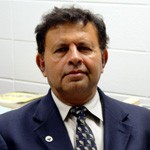Contribute
| Technology - Life Extension Of Power Plants |
Dr. Som Chattopadhyay
07/21/2004
(This article is sponsored by The Boston Group)
After graduating from IIT Kharagpur, I worked on my Ph.D. at Princeton University on a unique topic namely that of dynamic instability of elastic structures carrying electric currents. This area is of interest to the design of toroidal magnetic coils for fusion reactors (Tokamak) as well as that of superconducting magnets. After a brief post-doctoral work at Purdue, I started working with Westinghouse in Pittsburgh in their fusion power group on a contract jointly with Princeton University. Westinghouse soon phased out of the fusion power business and I moved to the liquid metal fast breeder reactor (LMFBR) program where I worked for a few years in the area of structural design of LMFBR reactors and steam generators. This program was eventually discontinued following a US congressional action and I have since been working in the commercial nuclear business involving pressurized water reactors (PWR) and steam generators at Westinghouse, first as a regular employee and in the recent years as a consultant during summers.
Since no nuclear power plants have been built in the US for quite some time, the work is primarily on life extension of the existing plants, and also on getting additional power from them. This presents a challenge to engineering design and analysis further complicated by stringent requirements from the US Nuclear Regulatory Commission (NRC). Another aspect of the experience at Westinghouse was developing quick solutions to engineering problems involving repair and replacement of power generation equipment within a very limited schedule between power outages. Back in the nineteen eighties I led a project that involved resolving a weld repair problem in a steam generator pressure vessel, thereby saving millions of dollars for the electric power utility.
The life extension activity involves looking at the load history (temperature excursions, pressure excursions, mechanical load excursions) that the plant components have gone through during the operating life. The structural analyst/designer then finds out how much margin exists in various components and accordingly decides whether the component(s) can make let us say another 20 years (the nuclear power plants are typically designed for a 40 year life). The life estimates are based on fatigue evaluations of various components and involve a lot of stress analyses. The multi-axial stresses are evaluated and appropriate fatigue characteristics of the structural materials are used in these evaluations. The approach is generally stress based. Alongside especially for the situations in which repair is involved, the concepts from fracture mechanics are used wherein the crack growth is monitored. The approach then is to investigate that a crack of certain size when detected initially can grow to a size that would cause a net-section failure. The crack is analytically driven by the actual load excursions using the principles of linear elastic fracture mechanics.
Power Uprating
A number of nuclear power plants have been “uprated,” and a number of them are proposed to be uprated. Typically the power outputs from the plants are increased anywhere from 5% to 10%. In doing so the activity is spread over the entire organization with revised fuel management and configuration and associated thermal conditions in the pressurized water coolant loop. The thermal conditions associated with the transients change substantially and the activity involves addressing the revised thermal and hydraulic conditions and associated thermal and stress analyses. The fatigue evaluations are also updated in the process to ensure that the structural integrity of the affected components is not compromised.
As one can see, this field is not only technically challenging but one has to deal with the social and political environment at every stage. This is especially critical for the nuclear power industry for which the public opinion has been adverse for quite sometime.
(Dr. Som Chattopadhyay is a also a Professor of Manufacturing Engineering at Ball State University in Muncie, Indiana and lived in the Boston area in the nineties. )
You may also access this article through our web-site http://www.lokvani.com/

